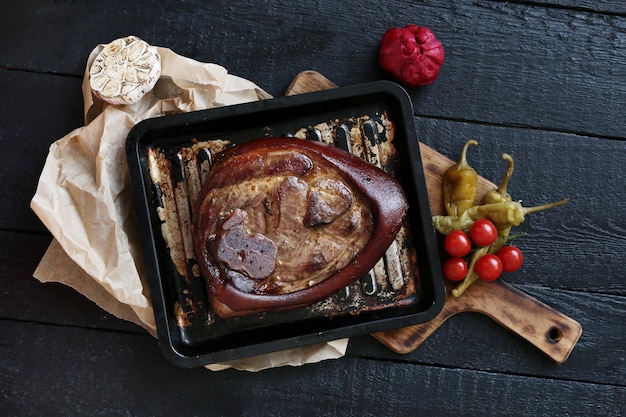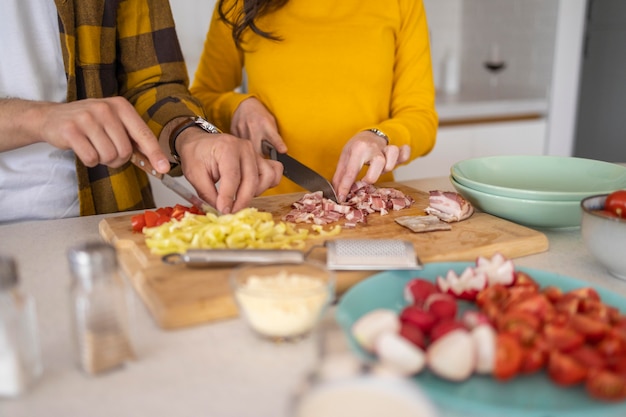cabbage rolls. Just the name conjures up images of warmth, comfort, and a symphony of flavours. It's a dish that takes me back to my childhood, to those long, lazy Sunday afternoons spent around the kitchen table with family. And while it's a classic, making the perfect cabbage roll, especially when it comes to timing, takes a bit of finesse.
So, let's dive into the world of cabbage roll cooking times. From the initial prep to the golden-brown finish, we'll cover every step to ensure your rolls are perfectly cooked and bursting with flavour.
Part 1: The Cabbage – The Foundation of Your Rolls

1.1 Choosing the Right Cabbage: A Matter of Texture and Size
The cabbage is the heart of the operation, the foundation for those beautiful rolls. It needs to be sturdy enough to hold its shape during cooking and pliable enough to roll without tearing. I've learned over the years that a large, firm head of green cabbage is the best bet, with tightly packed leaves. If you're feeling adventurous, try a red cabbage, but make sure it's free of any soft spots or discolouration.
1.2 Softening the Leaves: The Key to Easy Rolling
Now, onto the crucial step of softening those cabbage leaves. I've tried various methods, but simmering them in boiling water has always been my favourite. This gentle approach softens the leaves without making them mushy, allowing them to roll easily without tearing. It usually takes around 5 to 10 minutes, depending on the thickness of the leaves. Just watch for them to turn translucent, almost like a light green shade – that's your cue.
1.3 The Art of Blanching (Optional): Preserving the Green
Some folks swear by blanching their cabbage leaves, which involves quickly boiling them, then plunging them into ice water. This process helps preserve their vibrant green colour and crisp texture. It's entirely up to you, but I find it a bit of a fuss, personally.
Part 2: The Filling – The Heart and Soul of Your Rolls

2.1 The Classic Meat Filling: A Blend of Flavour and Texture
The filling is the star of the show, the essence of a good cabbage roll. A traditional filling usually involves ground meat, and here's where you can really get creative. I often use a mix of beef and pork, but you can stick with all beef or all pork, or even explore ground lamb for a change of pace.
2.2 The Perfect Blend of Flavour: A Symphony of Spices
Now, let's add some flavour to that meat. Onions and garlic are essential, and then you can unleash your inner spice master. I adore paprika, cumin, and a hint of cayenne pepper for a touch of warmth. You can also experiment with other spices like oregano, thyme, and even a pinch of cinnamon for a hint of sweetness.
2.3 Adding Those Extra Touches: Texture and Depth of Flavour
To add texture and depth of flavour, rice is a classic addition. It absorbs the flavours of the filling and creates a satisfying chew. Chopped vegetables like carrots, celery, or mushrooms also add a delightful crunch. Feeling adventurous? Try adding chopped spinach or even some chopped walnuts for a nutty twist.
Part 3: The Assembly – The Roll Call Begins

3.1 Laying the Foundation: A Cozy Home for Your Rolls
Now, let’s assemble those beauties. You'll need a baking dish or a large pot – enough space to accommodate all those rolls snugly. I always grease my dish with a bit of butter or oil to prevent sticking and ensure those rolls slide out easily.
3.2 Shaping Those Cabbage Roll Wonders: A Balancing Act of Filling and Folding
This is where the fun begins! Take a softened cabbage leaf and lay it flat. Place a generous spoonful of your meat filling in the centre, leaving about an inch of space at the bottom of the leaf. Now, gently roll the leaf up, tucking in the sides as you go. The trick is to make the rolls tight enough to hold their shape but not so tight they become a brick!
3.3 The Final Touches: Tucking Them in Tight
Once you’ve rolled all your cabbage leaves, tuck them neatly into your prepared dish. Make sure they are snug and packed together, but not too tightly. If you have any extra filling, you can spoon it over the top of the rolls.
Part 4: The Sauce – The Liquid Gold
4.1 The Classic Tomato Sauce: A Rich and Savoury Base
For a traditional cabbage roll, a delicious tomato sauce is essential. I love using good-quality crushed tomatoes, some tomato paste, and a splash of red wine. Adding a bit of onion, garlic, and your favourite herbs like basil, oregano, or rosemary will create a sauce that's both complex and comforting.
4.2 The Alternative Sauce Options: Exploring New Flavour Profiles
But, don't feel limited to tomato sauce! You can explore a world of other options. A creamy mushroom sauce, a tangy sour cream sauce, or even a simple broth can provide a different, equally delicious flavour profile.
4.3 The Importance of Sauce Coverage: Keeping Those Rolls Moist
Make sure the sauce completely covers all your cabbage rolls. This is crucial to keep them moist and prevent them from drying out as they cook.
Part 5: The Cooking – Getting That Perfect Golden Brown Finish
5.1 The Stovetop Method: Slow and Steady Cooking
You can cook cabbage rolls on the stovetop in a large pot with a lid. This is great for keeping a close eye on them. Just add enough water to cover the bottom of the pot and bring it to a simmer. Let them cook gently for about an hour and a half to two hours, or until they are tender and the filling is cooked through.
5.2 The oven method: A More Relaxed Approach
The other option is to bake them in the oven. Preheat your oven to 350°F (175°C). You can use a baking dish or a dutch oven. Cover the dish with foil for the first hour of cooking, then remove the foil and bake for another 30 minutes, or until the rolls are golden brown.
5.3 The Ideal Cooking Time: A Balancing Act of Patience and Temperature
Now, for the crucial question: how long do you cook those cabbage rolls? The answer depends on the method you’re using and the size of your rolls. On the stovetop, they’ll typically take about an hour and a half to two hours. In the oven, they’ll need around two hours. But, as with all things cooking, the best way to tell if they’re done is to check their internal temperature. They should reach an internal temperature of 165°F (74°C).
Part 6: The Resting – Letting Them Settle In
6.1 The Importance of Patience: Allowing the Flavours to Mingle
Once those cabbage rolls are cooked, don't rush to dig in! Let them rest for at least 15 minutes, covered, to allow the juices to redistribute and create a more tender and flavourful dish. It's a small step, but it makes a big difference.
6.2 The Time for Garnish: A Final Touch of Elegance
While those rolls are resting, get your garnish ready. Some fresh chopped parsley, a sprinkle of paprika, or even a dollop of sour cream can elevate the dish.
Part 7: Serving – The Grand Finale
7.1 The side dish Options: A Symphony of Flavours
Cabbage rolls are a versatile dish, so you can pair them with just about anything. mashed potatoes, rice, or a simple green salad are classic choices. But don't be afraid to experiment. A creamy polenta or a hearty lentil soup can also complement the richness of the rolls beautifully.
7.2 Serving with Care: A Presentation to Remember
Serve the cabbage rolls hot, straight from the oven or pot. Let everyone enjoy the delicious aromas and the comforting flavours. Present them on a platter, garnished with your chosen toppings, and let them take centre stage.
Part 8: Variations – Expanding Your Horizons
8.1 The Vegetarian Option: A World of Possibilities
If you’re looking for a vegetarian option, simply replace the meat filling with a mixture of lentils, quinoa, or even chickpeas. Use the same techniques for cooking, but you'll need to adjust the cooking time slightly as the vegetarian filling may cook quicker.
8.2 The International Twist: A Fusion of Flavours
Don't limit yourself to traditional cabbage rolls. Explore different cuisines! You can create Asian-inspired cabbage rolls with a filling of minced pork and shiitake mushrooms, or Italian-inspired rolls with a filling of ricotta cheese and spinach.
8.3 The Sweet and Savory Fusion: A Bold Experiment
If you’re feeling adventurous, you can even experiment with sweet and savoury flavours. Try a filling of dried fruit, nuts, and spices, or add a drizzle of maple syrup to your sauce.
Part 9: Storage and Reheating
9.1 Storing Those Delicious Leftovers: Preserving the Flavour
If you have any leftover cabbage rolls, you can store them in an airtight container in the refrigerator for up to 3 days.
9.2 Reheating Those Leftovers: Bringing Back the Warmth
To reheat them, you can simply pop them in the oven or microwave. For a more decadent reheating, try simmering them in some leftover sauce on the stovetop.
FAQs – Your Burning Questions Answered
1. Can I freeze cabbage rolls?
Yes, you can absolutely freeze cabbage rolls! Just make sure they are properly cooled before you freeze them. You can freeze them for up to 3 months. To reheat frozen cabbage rolls, simply thaw them in the refrigerator overnight and then cook them as usual.
2. How can I prevent the cabbage leaves from tearing when rolling?
Sometimes those leaves can be a bit stubborn. To prevent tearing, make sure you soften them thoroughly in boiling water. You can also use a small amount of flour or cornstarch on the leaves before rolling to help them stick together.
3. What can I do if my cabbage rolls are too dry?
If your cabbage rolls are a bit dry, you can add a bit more sauce or even a splash of broth to the pot or baking dish. You can also simmer them on the stovetop for a few more minutes until they are more tender and moist.
4. Why are my cabbage rolls falling apart?
If your cabbage rolls are falling apart, it could be because the cabbage leaves are not softened enough. Try simmering them for a few more minutes until they are more pliable. It could also be that your filling is too wet. Try draining off any excess liquid before you start rolling.
5. Can I use different types of cabbage?
Yes, you can experiment with different types of cabbage. While green cabbage is the most common, you can also use savoy cabbage, red cabbage, or even Napa cabbage. Just remember that the cooking time may vary depending on the type of cabbage you use.
There you have it! A comprehensive guide to cabbage roll cooking time. Now, go forth and create your own delicious cabbage roll masterpieces. Bon appétit!
Everyone is watching

Corn on the Cob: The Ultimate Guide to Perfectly Cooked Ears
Healthy MealsAh, corn on the cob. Just the name evokes images of sunny days, barbecues, and that sweet, juicy flavour that ...

Perfect Pork Roast Oven Cooking Time: A Guide to Delicious Results
Healthy MealsThere's something truly satisfying about a perfectly roasted pork. The aroma alone is enough to make your mout...

Ham Cooking Time: How Long to Bake, Smoke, or Boil a Delicious Ham
Healthy MealsAh, ham. It's a classic, isn't it? A real crowd-pleaser, especially around holidays. And when done right, it'...

Scallops: The Ultimate Guide to Perfect Cooking
Healthy MealsAh, scallops. Those delicate, sweet, and utterly delicious morsels of the sea. They hold a special place in my...

Spaghetti Squash: The Ultimate Guide to Cooking and Serving
Healthy MealsRemember that time you saw spaghetti squash at the supermarket, looking all bumpy and strange, and thought, "W...
